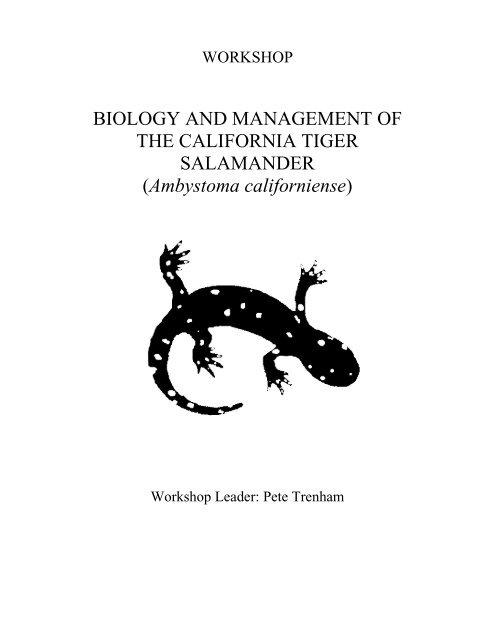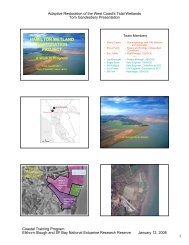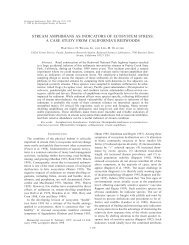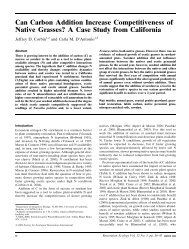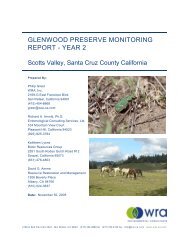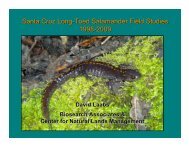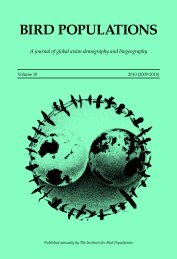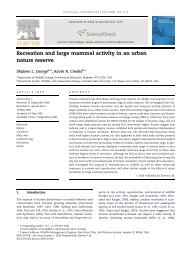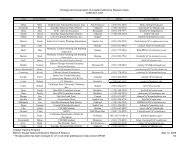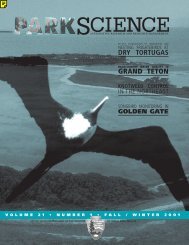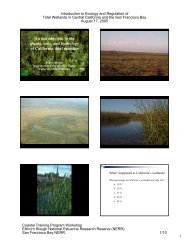California Tiger Salamander Bibliography - the Elkhorn Slough ...
California Tiger Salamander Bibliography - the Elkhorn Slough ...
California Tiger Salamander Bibliography - the Elkhorn Slough ...
Create successful ePaper yourself
Turn your PDF publications into a flip-book with our unique Google optimized e-Paper software.
WORKSHOP<br />
BIOLOGY AND MANAGEMENT OF<br />
THE CALIFORNIA TIGER<br />
SALAMANDER<br />
(Ambystoma californiense)<br />
Workshop Leader: Pete Trenham
Timeline of Events in History of Ambystoma californiense<br />
1853 Species named by John Edward Gray (Keeper of Zoology at <strong>the</strong> British Museum)<br />
1925 Tracy Storer publishes <strong>the</strong> first detailed description of <strong>the</strong> species and its habits<br />
1971 CDFG suggested CTS be added to list of protected amphibians<br />
1982 CDFG adds CTS to Special Animal List (later, Species of Special Concern)<br />
1985 USFWS places CTS in category 2 list of candidate species for ESA listing<br />
1992 USFWS considers proposal for listing CTS under ESA<br />
1994 USFWS concludes that listing is “warranted but precluded” by higher priorities<br />
2000 USFWS lists Santa Barbara County distinct population segment as endangered<br />
2003 USFWS lists Sonoma County distinct population as endangered<br />
2004 USFWS list Central distinct population segment as threatened<br />
- listing includes 4d rule exempting routine ranching procedures from regulation<br />
2010 <strong>California</strong> Department of Fish and Game lists CTS as threatened throughout range<br />
Glossary of Terminology Used<br />
Adult – A tiger salamander that is capable of breeding. Breeding adult males are<br />
identifiable by <strong>the</strong>ir swollen vent and an enhanced tail fin. Sex can be difficult to assign<br />
accurately outside of <strong>the</strong> breeding season. Most adults are >80 mm SVL.<br />
Aestivation – A sleep-like state of complete inactivity and reduced metabolism like<br />
hibernation, but occurring during <strong>the</strong> summer. Although tiger salamander aestivation is<br />
commonly discussed, no author has ever published a report of aestivating <strong>California</strong> tiger<br />
salamanders. Upland habitat is sometimes called aestivation habitat.<br />
Fossorial – Adapted for digging. <strong>Tiger</strong> salamanders do not dig <strong>the</strong>ir own burrows, but<br />
ra<strong>the</strong>r occupy <strong>the</strong> burrows of fossorial mammals.<br />
Egg – An unfertilized ovum.<br />
Embryo – The stage from egg fertilization through emergence from <strong>the</strong> embryonic jelly<br />
coat. Inseminated females attach embryos to grass and o<strong>the</strong>r debris in shallow portions<br />
of breeding ponds.<br />
Juvenile – The stage of development between metamorphosis and adulthood. These look<br />
like adults in coloration and morphology, but are usually smaller.<br />
Larva – The aquatic free-swimming gilled stage of development beginning after<br />
emergence from <strong>the</strong> embryonic jelly coat and ending at metamorphosis.
Metamorph – The brief and transient period of development between aquatic larval<br />
development and <strong>the</strong> completely terrestrial juvenile stage. Metamorphs are intermediate<br />
in morphology and coloration, often with partially resorbed gills and tail fins and a little<br />
of <strong>the</strong> final color pattern observable. Metamorphs are usually detected in and around<br />
breeding ponds in spring and summer.<br />
Metamorphosis – The process of transformation from an aquatic larva to a terrestrial<br />
juvenile. During this process gills and tail fins are resorbed, lungs develop, and<br />
coloration and <strong>the</strong> overall morphology begins to change to <strong>the</strong> terrestrial form. Larvae<br />
beginning metamorphosis can be detected by inspection of <strong>the</strong>ir gills and tail fin.<br />
Paedomorph – In permanent ponds larvae of A. tigrinum sometimes become sexually<br />
mature larvae, living a completely aquatic life and never metamorphosing. This<br />
phenomenon has never been observed in A. californiense, but may occur in hybrids.<br />
Spermatophore – A sperm capped cone of jelly that male salamanders deposit on <strong>the</strong><br />
ground or pond-bottom and female salamanders pick up with <strong>the</strong>ir cloacae facilitating<br />
internal fertilization.<br />
Subadult – A term essentially meaning <strong>the</strong> same thing as juvenile, above.<br />
Annotated <strong>Bibliography</strong> of <strong>the</strong> Main CTS References (updated 4/2009)<br />
Alvarez, J.A. 2004. Overwintering <strong>California</strong> tiger salamander (Ambystoma<br />
californiense) larvae. Herpetological Review 35:344.<br />
Although A. tigrinum larvae commonly remain larval for >1 year in permanent water<br />
habitats, this was <strong>the</strong> first observation of A. californiense remaining larval into <strong>the</strong>ir<br />
second winter. However, A. californiense are still not thought to form sexually mature<br />
larvae (paedomorphs)<br />
Alvarez, J.A. 2004. Use of artificial egg laying substrate to detect <strong>California</strong> tiger<br />
salamanders (Ambystoma californiense). Herpetological Review 35:45-46.<br />
CTS embryos were found in many pools where later in <strong>the</strong> season no larvae were<br />
detected. Explains method for creating laying substrates to non-destructively sample for<br />
embryos.<br />
Anderson, J. D. 1968. A comparison of <strong>the</strong> food habits of Ambystoma<br />
macrodactylum sigillatum, Ambystoma macrodactylum croceum, and Ambystoma<br />
tigrinum californiense. Herpetologica 24:273-284.<br />
Young A. californiense larvae eat primarily small zooplankton with larger individuals<br />
shifting to a diet focused largely on tadpoles of Hyla regilla and Rana draytonii.
Austin, C.C. and H.B. Shaffer 1992. Short, medium, and long-term repeatability of<br />
locomotor performance in <strong>the</strong> tiger salamander, Ambystoma californiense. Functional<br />
Ecology 6(2):145-153.<br />
Cook, D.G., P.C. Trenham and P.T. Nor<strong>the</strong>n. 2006. Demography and breeding<br />
phenology of <strong>the</strong> <strong>California</strong> tiger salamander Ambystoma californiense) in an urban<br />
landscape. Northwestern Naturalist 87:215-224.<br />
Drift fence study of breeding migrations at a large vernal pool in an urbanizing area of<br />
Santa Rosa, Sonoma County. Adults were captured as <strong>the</strong>y arrived at <strong>the</strong> breeding pond<br />
in 1999, 2002 and 2003. Total numbers of adults estimated to be breeding at this pond<br />
ranged from 65 to 107. Whereas some males arrived at <strong>the</strong> ponds following <strong>the</strong> first rains,<br />
females only arrived in substantial numbers after <strong>the</strong> pond filled. Yearly breeding<br />
migrations began anywhere from November to January, depending on rainfall.<br />
Barry, S.J., and H.B. Shaffer. 1994. The status of <strong>the</strong> <strong>California</strong> tiger salamander<br />
(Ambystoma californiense) at Lagunita: a 50-year update. J. of Herpetology 28:159-164.<br />
Summary of <strong>the</strong> ecology, natural history and history of <strong>the</strong> CTS population on Stanford’s<br />
campus. Established strategy still used for managing <strong>the</strong> draw-down of Lagunita to<br />
minimize larval CTS mortality.<br />
Davidson, C., H.B. Shaffer, and M.R. Jennings. 2002. Spatial tests of <strong>the</strong> pesticide<br />
drift, habitat destruction, UV-B, and climate-change hypo<strong>the</strong>ses for <strong>California</strong> amphibian<br />
declines. Conservation Biology 16:1588-1601.<br />
Whereas upwind pesticide use is strongly correlated with <strong>the</strong> disappearance of four of<br />
<strong>California</strong>’s ranid frogs, no similar correlation was observed for CTS disappearance sites.<br />
For CTS <strong>the</strong> most significant difference between extant and extirpated sites was that<br />
extant sites had significantly less urbanized land within 5km.<br />
Fisher, R.N. and H.B. Shaffer. 1996. The decline of amphibians in <strong>California</strong>'s Great<br />
Central Valley Conservation Biology, 10:1387-1397.<br />
Documented rarity of native amphibians in <strong>the</strong> low elevation portions of <strong>the</strong> central<br />
valley. Attributed decline to habitat loss and disturbance in <strong>the</strong> agricultural central valley<br />
and also introduced predators. First peer reviewed study of general decline in <strong>California</strong>.<br />
Fitzpatrick B.M., J.R. Johnson, D.K. Kump, J.J. Smith, S.R. Voss, and H.B. Shaffer.<br />
2010. Rapid spread of invasive genes into a threatened native species. Proceedings of <strong>the</strong><br />
National Academy of Sciences of <strong>the</strong> United States of America 107:3606-3610.<br />
Genetic assessments of samples along a transect from Salinas to Alameda County<br />
indicate that in general genes from <strong>the</strong> introduced tiger salamanders have not spread far<br />
beyond <strong>the</strong> sites of original introduction. However, three genes show a very different<br />
pattern with rapid spread far beyond <strong>the</strong> apparent sites of introduction, indicating that<br />
natural selection is favoring <strong>the</strong> spread of <strong>the</strong>se markers. This complicates <strong>the</strong> assessment<br />
of hybrid versus native status. An example from Fort Ord show that only one population<br />
has a large fraction of introduced genes for markers o<strong>the</strong>r than <strong>the</strong>se exceptional markers
– for <strong>the</strong> exceptional markers all populations are fixed for two of <strong>the</strong>se non-native<br />
markers.<br />
Fitzpatrick B.M., and H.B. Shaffer. 2007. Introduction history and habitat variation<br />
explain <strong>the</strong> landscape genetics of hybrid tiger salamanders. Ecological Applications<br />
17:598-608.<br />
The current distribution of introduced alleles is largely contained in <strong>the</strong> Salinas Valley.<br />
The spatial transition from highly mixed genetic makeup to nearly pure native<br />
populations was abrupt, suggesting ei<strong>the</strong>r cryptic barriers to dispersal or locally rapid<br />
displacement of natives by an advancing hybrid swarm. At a more ecological level,<br />
highly modi. ed perennial breeding ponds had higher introduced allele frequencies than<br />
more natural seasonal ponds, suggesting greater invasion success in perennial breeding<br />
ponds.<br />
Fitzpatrick B.M., and H.B. Shaffer. 2007. Hybrid vigor between native and<br />
introduced salamanders raises new challenges for conservation. Proceedings of <strong>the</strong><br />
National Academy of Sciences of <strong>the</strong> United States of America 104:15793-15798.<br />
Genetic analysis suggests that larvae containing an intermediate mixture of genes from<br />
native and introduced tiger salamanders have higher survivorship than those containing<br />
mostly native or mostly introduced genes. Suggests that hybrids might spread.<br />
Fitzpatrick, B.J., and H.B. Shaffer. 2004. Environment dependent admixture<br />
dynamics in a tiger salamander hybrid zone. Evolution 58:1282–1293.<br />
In an area where A. tigrinum were introduced by bait dealers, hybrids of A. tigrinum and<br />
A. californiense are now present. Genetic assays indicated that salamanders present in<br />
permanent constructed ponds contained greater proportions of A. tigrinum alleles;<br />
ephemeral constructed ponds and natural vernal pools generally contained more A.<br />
californiense alleles. Eliminating permanent ponds by draining or physical modification<br />
may limit <strong>the</strong> spread of hybrid genes.<br />
Holland, D.C., M.P. Hayes, and E. McMillan. 1990. Late summer movement and<br />
mass mortality in <strong>the</strong> <strong>California</strong> tiger salamander (AMBYSTOMA CALIFORNIENSE).<br />
Southwestern Naturalist 35:217-220.<br />
An unusual August rainstorm initiated a mass migration of recently metamorphosed<br />
salamanders from a large pond in San Luis Obispo County. Large numbers of <strong>the</strong>se<br />
animals died on <strong>the</strong> surface and under debris.
Holland, R.F. 1998. Great Valley vernal pool distribution, photorevised. Pages 71-75<br />
in C. W. Witham et al., editors. Ecology, conservation, and management of vernal pool<br />
ecosystems. <strong>California</strong> Native Plant Society, Sacramento.<br />
Using air photos, estimated <strong>the</strong> area of vernal pool complexes remaining and also <strong>the</strong><br />
areas lost since an earlier study. Estimates are on a county-wide basis and cover only <strong>the</strong><br />
Central Valley. (http://www.dfg.ca.gov/whdab/wetlands/vp_holland/report_index.htm)<br />
Jennings, M.R. 1996. Geographic Distribution. Ambystoma californiense. Herpetol.<br />
Rev., 27(3): 147.<br />
Jennings, M.R. 1996. Ambystoma californiense. Burrowing Ability. Herpetol. Rev.,<br />
27(4): 194.<br />
Description of an A. californiense digging its way through a burrow plug to enter a<br />
pocket gopher burrow. Use of <strong>the</strong>se burrows was known but this was <strong>the</strong> first<br />
observation of a salamander forcing its way into a plugged burrow.<br />
Johnson, J.R. et al. 2011. The origin of tiger salamander (Ambystoma tigrinum)<br />
populations in <strong>California</strong>, Oregon, and Nevada: introductions or relicts? Conservation<br />
Genetics 12:355-370.<br />
Introduced populations of A. tigrinum exist in nor<strong>the</strong>rn and sou<strong>the</strong>rn <strong>California</strong> and in <strong>the</strong><br />
Sierra Nevada. Populations of tiger salamanders near <strong>the</strong> Oregon border are potentially<br />
native A. tigrinum as <strong>the</strong>y are most closely releated to Washington populations.<br />
Loredo, I., D. Van Vuren, and M.L. Morrison. 1996. Habitat use and migration of <strong>the</strong><br />
<strong>California</strong> tiger salamander. Journal of Herpetology 30:282-285.<br />
Following <strong>the</strong> initial night of emigration by adult and recently metamorphosed CTS at a<br />
Contra Costa County site, <strong>the</strong>y found that 83% of adults disappeared into ground squirrel<br />
holes while 54% of new metamorphs entered ground squirrel holes and 46% surface<br />
cracks. Occupied and unoccupied ground squirrel burrow were used equally. Adults<br />
moved up to 129 m and new metamorphs up to 57 m.<br />
Loredo, I., and D. Van Vuren. 1996. Reproductive ecology of a population of <strong>the</strong><br />
<strong>California</strong> tiger salamander. Copeia 1996:895-901.<br />
Three year study of one breeding pond in Contra Costa County. Metamorph production<br />
was 1248, 481 and 3 across <strong>the</strong>se three seasons. Some new metamorphs marked in <strong>the</strong><br />
first year of <strong>the</strong> study were later recaptured as 2 year old breeding adults. The timing of<br />
breeding migrations was strongly correlated with rainfall events.<br />
Marty J.T. 2005. Effects of cattle grazing on diversity in ephemeral wetlands.<br />
Conservation Biology 19:1626-1632.<br />
Orloff, S.G. 2011. Movement patterns and migration distances in an upland<br />
population of <strong>California</strong> tiger salamander (Ambystoma californiense). Herpetological<br />
Cosnervation and Biology 6:266-276.
Five year effort to capture and remove CTS from a large development project in Contra<br />
Costa County revealed large number of adult and subadult CTS on <strong>the</strong> order of 1000m<br />
from known breeding ponds. Animals did not appear to use any obvious corridors in <strong>the</strong><br />
landscape and were roughly evenly distributed. Even after fiver years of drift fence<br />
trapping, significant numbers of salamanders remained within <strong>the</strong> proposed project area.<br />
Padgett-Flohr, G.E., and J.E. Longcore. 2005. Ambystoma californiense. Fungal<br />
infection. Herpetological Review 36:50-51.<br />
Evidence of “chytrid” fungal infection in wild-caught Santa Clara County CTS larvae.<br />
Petranka, J.W. 1998. <strong>Salamander</strong>s of <strong>the</strong> United States and Canada. Smithsonian<br />
Institution Press, Washington DC, pp 47-50.<br />
Good summary of literature available in 1998, but misses many of later publications.<br />
Picco A.M., J.L. Brunner, and J.P. Collins. 2007. Susceptibility of <strong>the</strong> endangered<br />
<strong>California</strong> tiger salamander, Ambystoma californiense, to Ranavirus infection.<br />
Source: Journal of Wildlife Diseases 43:286-290.<br />
Infection has not been documented in <strong>the</strong> field, but susceptibility is documented<br />
emphasizing <strong>the</strong> importance of minimizing potential for introduction of this agent.<br />
Pyke, C. 2005. Assessing suitability for conservation action: prioritizing interpond<br />
linkages for <strong>the</strong> <strong>California</strong> tiger salamander. Conservation Biology 19: 492-503<br />
Used complex models to assess habitat connectivity of known breeding ponds in Santa<br />
Barbara County, and prioritize areas for conservation action. Model shows three to five<br />
remaining subareas which are fairly well connected by intact upland habitat corridors.<br />
Pyke, C. and J. Marty. 2005. Cattle grazing mediates climate change impacts on<br />
ephemeral wetlands. Conservation Biology 19:1619-1625<br />
Grazing played an important role in maintaining <strong>the</strong> suitability of vernal pool<br />
hydrological conditions for fairy shrimp and salamander reproduction. Without grazing,<br />
after 3 years pools dried an average of 50 days earlier.<br />
Riley S.P.D., H.B. Shaffer, S.R. Voss, and B.M. Fitzpatrick. 2003. Hybridization<br />
between a rare, native tiger salamander (Ambystoma californiense) and its introduced<br />
congener. Ecological Applications 13: 1263–1275.<br />
First published evidence of hybridization between native A. californiense and introduced<br />
A. tigrinum. Populations studied were in <strong>the</strong> Salinas Valley, Monterey County.<br />
Ryan, M. E., J. R. Johnson, B. M. Fitzpatrick, L. J. Lowenstine, A. M. Picco, and H.<br />
B. Shaffer. 2012. Lethal effects of pond water quality on threatened <strong>California</strong><br />
salamanders but not on co-occurring hybrid salamanders. Conservation Biology 27: 95-<br />
102.
Dramatic die-offs of <strong>California</strong> tiger salamander larvae were observed in late spring<br />
(April/May) in experimental enclosures in Salinas Valley ponds. A veterinary pathologist<br />
involved with <strong>the</strong> project determined that larvae were starving and oxygen-stressed,<br />
likely due to chemical exposure. Data did not suggest disease or pathogens as <strong>the</strong> cause.<br />
Ponds experiencing die-offs had approximately 10x more pesticide applications within<br />
1.6 km in <strong>the</strong> weeks leading up to <strong>the</strong>se observations than occurred in <strong>the</strong> area around<br />
ponds without die-offs.<br />
Ryan M.E., J.R. Johnson, and B.M. Fitzpatrick. 2009. Invasive hybrid tiger<br />
salamander genotypes impact native amphibians. Proceedings of <strong>the</strong> National Academy<br />
of Sciences 106: 11166-11171.<br />
In artificial ponds, hybrids reduce <strong>the</strong> growth and survival of native <strong>California</strong> tiger<br />
salamanders. In ponds with hybrids far fewer newts and treefrogs survived to<br />
metamorphosis. This study indicates that hybrids not only displace native CTS but<br />
adversely affect <strong>the</strong>m where <strong>the</strong> two co-occur and strongly impact o<strong>the</strong>r species.<br />
Searcy C.A. and H.B. Shaffer. 2008. Calculating biologically accurate mitigation<br />
credits: insights from <strong>the</strong> <strong>California</strong> tiger salamander. Conservation Biology 22: 997-<br />
1005.<br />
The authors used upland capture rates in traps 10, 100, 200, 300, 400, 500, 600, 700, 850<br />
and 1000 m from Olcott Lake (a large playa pool) in Solano County. Adult and juvenile<br />
CTS were captured at all distances, but numbers captured declined with distance from <strong>the</strong><br />
pond. On average, approximately 1 adult and 7 juveniles per trap were captured 1 km out<br />
from <strong>the</strong> pond, while at 100 m averages per trap were 27 juveniles and 10 adults. These<br />
results indicate that lots of CTS are hundreds of meters from <strong>the</strong> pond. The authors<br />
suggest a method for assigning mitigation value based on salamander densities.<br />
Shaffer, H.B., C.C. Austin, and R.B. Huey. 1991. The consequences of<br />
metamorphosis on salamander (Ambystoma) locomotor performance. Physiological<br />
Zoology 64: 212–231.<br />
In <strong>the</strong> lab <strong>the</strong>y found that salamanders on a treadmill can walk at 5 cm/s for about 8<br />
minutes (20 m) before succumbing to exhaustion. *more recent studies have shown this<br />
to be temperature dependent – at higher temperatures <strong>the</strong>y can walk far<strong>the</strong>r.<br />
Shaffer, H.B., J.M. Clark, and F. Kraus. 1991. When molecules and morphology<br />
clash: a phylogenetic analysis of <strong>the</strong> North American ambystomatid salamanders<br />
(Caudata: Ambystomatidae). Systematic Zoology 40:284-303.<br />
Early evolutionary analysis of <strong>the</strong> tiger salamanders of North America in which <strong>the</strong><br />
authors try to resolve conflicting results of protein and morphological variation.<br />
Shaffer, H.B., R.N. Fisher, and S.E. Stanley. 1993. Status report: <strong>the</strong> <strong>California</strong> tiger<br />
salamander (Ambystoma californiense). Final report to <strong>the</strong> <strong>California</strong> Department of Fish<br />
and Game.<br />
Summary of state-wide surveys of known historic localities and also available suitable<br />
habitat. In many cases <strong>the</strong>y were unable to find CTS at historic sites, sometimes because
no habitat to sample remained. These data went into <strong>the</strong> later paper by Fisher and Shaffer<br />
(1996). Contains data on habitat, water quality and predators at most sampled sites.<br />
Shaffer H.B. and M.L. McKnight. 1996. The polytypic species revisited: genetic<br />
differentiation and molecular phylogenetics of <strong>the</strong> tiger salamander Ambystoma tigrinum<br />
(Amphibia: Caudata) complex. Evolution 50: 417–433.<br />
Based on mitochondrial DNA variation <strong>the</strong>y find A. californiense to be a strongly<br />
differentiated and unique group, but <strong>the</strong> rest of <strong>the</strong> picture is less clear. All o<strong>the</strong>r species<br />
in this group are more closely related to each o<strong>the</strong>r than <strong>the</strong>y are to A. californiense. CTS<br />
were isolated 5 million years ago.<br />
Shaffer, H.B., G.B. Pauly, J.C. Oliver and P.C. Trenham. 2004. The molecular<br />
phylogenetics of endangerment: cryptic variation and historical phylogeography of <strong>the</strong><br />
<strong>California</strong> tiger salamander, Ambystoma californiense. Molecular Ecology 13: 3033-<br />
3049.<br />
Identified 6 genetic groups of CTS in different parts of <strong>California</strong>. Sonoma and Santa<br />
Barbara County groups were <strong>the</strong> most distinct, possibly even warranting recognition as<br />
separate species. O<strong>the</strong>r distinct, but less deeply diverged, groups were centered around<br />
<strong>the</strong> San Francisco Bay Area, <strong>the</strong> Central Valley, <strong>the</strong> Central Coast region, and <strong>the</strong><br />
Sou<strong>the</strong>rn San Joaquin Valley. Results suggest it may be important to avoid mixing CTS<br />
from different areas (i.e., from salvage efforts).<br />
Shaffer, H.B. and P.C. Trenham. 2005. The <strong>California</strong> tiger salamander (Ambystoma<br />
californiense). In M.J. Lannoo (Ed.), Status and Conservation of U.S. Amphibians.<br />
University of <strong>California</strong> Press, Berkeley, CA.<br />
Complete overview of CTS status, ecology, and natural history.<br />
Stebbins, R.C. 1985. A field guide to western reptiles and amphibians. Second<br />
edition. Houghton Mifflin Company, Boston, Massachusetts. xiv + 336 pp.<br />
Storer, T.I. 1925. A synopsis of <strong>the</strong> Amphibia of <strong>California</strong>. University of <strong>California</strong><br />
Publications in Zoology 27:1-342.<br />
Earliest publication including some basic information on CTS biology, descriptions of<br />
embryos and larvae, and natural history.<br />
Trenham, P.C. 2001. Terrestrial habitat use by adult <strong>California</strong> tiger salamanders.<br />
Journal of Herpetology 35:343-346.<br />
Using radio tracking, emigration of adults was followed after breeding for up to 4<br />
months. All animals tracked used ground squirrel burrows. Average distance moved was<br />
about 100 m. One of <strong>the</strong> 11 animals was tracked to a burrow 248 m from <strong>the</strong> pond where<br />
it bred. Movements on rainy nights were considerably longer than those on nights<br />
without rain.<br />
Trenham, P.C. & Cook, D. G. 2008. Distribution of migrating adults related to <strong>the</strong><br />
location of remnant grassland around an urban <strong>California</strong> tiger salamander (Ambystoma
californiense) breeding pool. In R. E. Jung & J.C. Mitchell (Eds.), Urban Herpetology,<br />
Herpetological Conservation, Vol. 3, Society for <strong>the</strong> Study of Amphibians and Reptiles,<br />
Salt Lake City, UT, USA.<br />
At a breeding pond in Santa Rosa most adults were captured entering on <strong>the</strong> east side of<br />
<strong>the</strong> pond. This appears to be because substantial grassland habitat only remains in this<br />
direction. Captures did not appear to be related to <strong>the</strong> amount of grassland within 100 m<br />
of <strong>the</strong> pool but to <strong>the</strong> amounts far<strong>the</strong>r away (200 – 700 m).<br />
Trenham, P.C., W.D. Koenig, and H.B. Shaffer. 2001. Spatially autocorrelated<br />
demography and interpond dispersal in <strong>the</strong> <strong>California</strong> tiger salamander, Ambystoma<br />
californiense. Ecology 82: 3519-3530.<br />
Animals marked at 10 different breeding ponds along a 3km transect were recaptured<br />
over a period of three years. Roughly 25% of recaptured CTS were at a pond o<strong>the</strong>r than<br />
<strong>the</strong> one where <strong>the</strong>y were originally marked. Individuals moved between ponds separated<br />
by up to 680 meters. This reflects more interpond dispersal than would have been<br />
expected previously.<br />
Trenham, P.C. and H.B. Shaffer. 2005. Amphibian upland habitat use and its<br />
consequences for population viability. Ecological Applications 15:158-1168.<br />
Single season study of CTS densities in upland habitat around Olcott Lake, Solano<br />
County. Capture rates of adults was highest in traps 10 m from <strong>the</strong> pond and declined in<br />
traps far<strong>the</strong>r out; subadult capture rates during <strong>the</strong> winter months were lowest at 10 m<br />
from <strong>the</strong> pond and peaked in traps 400 m out. Estimated that 95% of both subadults and<br />
adults remain within 630 m of this breeding pond, and that ponds with 600 m of intact<br />
upland habitat surrounding <strong>the</strong>m will support populations near <strong>the</strong>ir natural capacity.<br />
Trenham, P.C., H.B. Shaffer, W.D. Koenig, and M.R. Stromberg. 2000. Life history<br />
and demographic variation in <strong>the</strong> <strong>California</strong> tiger salamander (Ambystoma californiense).<br />
Copeia 2000:365-377.<br />
Seven year study of CTS in one ephemeral constructed livestock pond in Monterey<br />
County. Showed that
migrations; on first nights of <strong>the</strong> migration almost all individuals observed were males (a<br />
common observation).<br />
U.S. Fish and Wildlife Service (USFWS). 19 January 2000. Emergency rule to list <strong>the</strong><br />
Santa Barbara County distinct population of <strong>the</strong> <strong>California</strong> tiger salamander as<br />
endangered. Federal Register 65(12):3096-3109. Proposal to list <strong>the</strong> Santa Barbara<br />
County distinct population of <strong>the</strong> <strong>California</strong> tiger salamander as endangered. Federal<br />
Register 65(12):3110-3111.<br />
U.S. Fish and Wildlife Service (USFWS). 21 September 2000. Final rule to list <strong>the</strong><br />
Santa Barbara County distinct population of <strong>the</strong> <strong>California</strong> tiger salamander as<br />
endangered. Federal Register 65(184):57242-57264.<br />
U.S. Fish and Wildlife Service (USFWS). 13 June 2002. Review of species that are<br />
candidates or proposed for listing as endangered or threatened; annual notice of findings<br />
on recycled petitions; annual description of progress on listing actions. Federal Register<br />
67(114):40657-40679.<br />
U.S. Fish and Wildlife Service (USFWS). 22 July 2002. Listing <strong>the</strong> Sonoma County<br />
distinct population segment of <strong>the</strong> <strong>California</strong> tiger salamander as endangered. Federal<br />
Register 67(140):47726-47740.<br />
U.S. Fish and Wildlife Service (USFWS). 19 March 2003. Determination of<br />
endangered status for <strong>the</strong> Sonoma County distinct population segment of <strong>the</strong> <strong>California</strong><br />
tiger salamander. Federal Register 68(53):13498-13520.<br />
U.S. Fish and Wildlife Service (USFWS). 4 August 2004. Determination of<br />
threatened status for <strong>the</strong> <strong>California</strong> tiger salamander; and special rule exemption for<br />
existing routine ranching activities; final rule. Federal Register 69(149):47212-47248.<br />
Wang, I. H.B. Shaffer, and W.K. Savage. 2009. Landscape genetics and least-cost<br />
path analysis reveal unexpected dispersal routes in <strong>the</strong> <strong>California</strong> tiger<br />
salamander (Ambystoma californiense). Molecular Ecology 18: 1365-1374.<br />
They ga<strong>the</strong>red genetic data on animals from 16 ponds in <strong>the</strong> Fort Ord area, and found<br />
evidence supporting recent dispersal between 4 pairs of ponds separated by from 1.0 –<br />
1.3 km. They combined <strong>the</strong> genetic data with an analysis of <strong>the</strong> upland habitat<br />
salamanders would have to cross between <strong>the</strong>se 4 pairs of ponds. This analysis suggested<br />
that CTS travel most easily through chaparral. Travel across grassland appears to be<br />
twice as costly, and through oak woodland five times more costly.<br />
Wang, I. J.J. Johnson, B.B. Johnson, and H.B. Shaffer. 2011. Effective population<br />
size is strongly correlated with breeding pond size in <strong>the</strong> endangered <strong>California</strong> tiger<br />
salamander (Ambystoma californiense). Conservation Genetics 12:911-920
Some Useful Websites:<br />
<strong>California</strong> Department of Fish and Game Non-Game Wildlife Program Publications<br />
http://www.dfg.ca.gov/wildlife/nongame/publications/<br />
Nature Serve – background summary for CTS<br />
http://www.natureserve.org/explorer/<br />
<strong>California</strong> Herps – online directory of species descriptions and lots of photos<br />
www.californiaherps.com<br />
Survey Guidelines – released jointly by FWS and CDFG<br />
http://www.fws.gov/sacramento/ES/Survey-Protocols-Guidelines/es_survey.htm<br />
Sacramento Fish and Wildlife Office – Information regarding minimum qualifications for<br />
obtaining a recovery permit for CTS and o<strong>the</strong>r species<br />
http://www.fws.gov/cno/es/minqual.html<br />
Shaffer Lab Webpage – Access to most publications by Brad Shaffer and collaborators<br />
http://www2.eve.ucdavis.edu/shafferlab/<br />
Some Suppliers:<br />
Wind & Shade Screens Inc. (High Quality Drift Fence Material)<br />
544 S Pacific St # D103<br />
San Marcos, CA 92078<br />
(760) 761-4994<br />
<strong>California</strong> Glass (Pitfall Buckets)<br />
A Saxco Company<br />
155 98th Avenue<br />
Oakland, CA 94603-1003<br />
Tel: (510) 635-7700<br />
Fax: (510) 635-4288<br />
Nichols Net and Twine (Dip Nets and Seines)<br />
1.800.878.NETS (6387)<br />
Fax: 618.797.0212<br />
email: nicholsnt@yahoo.com<br />
(or john@nicholsnetandtwine.com)


